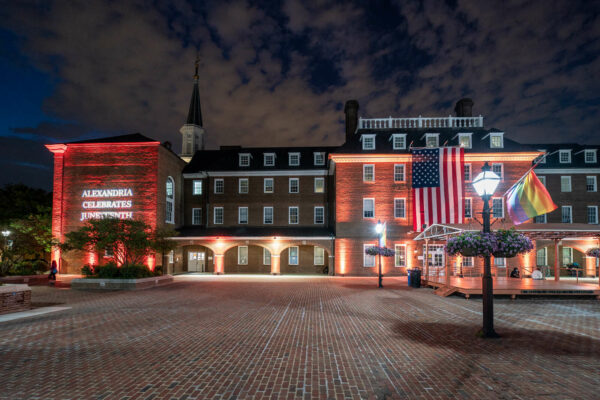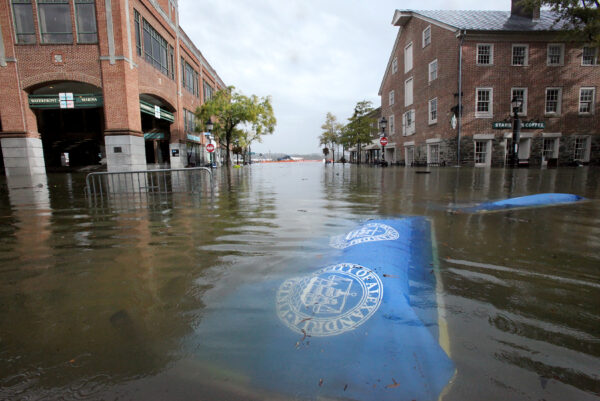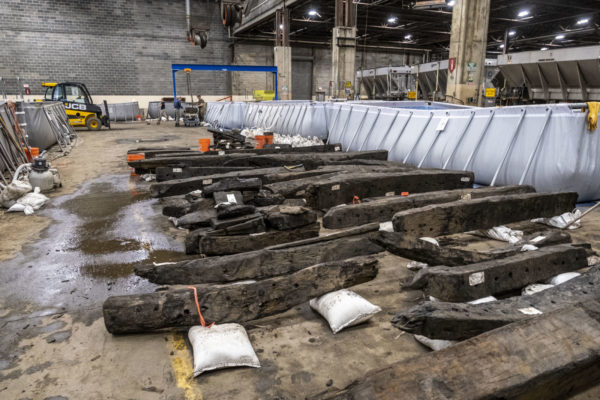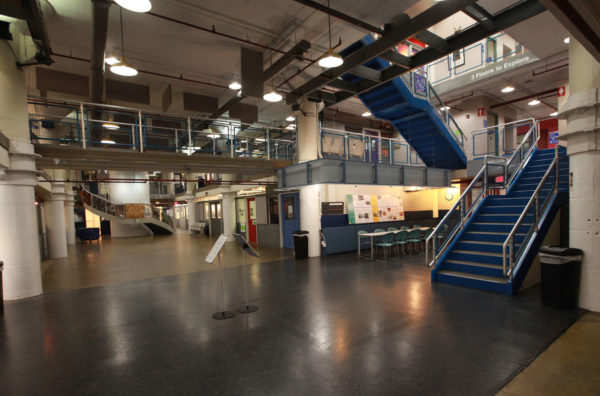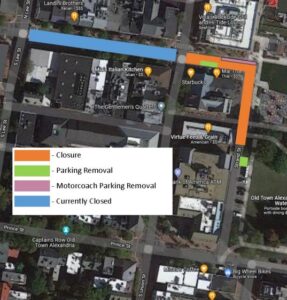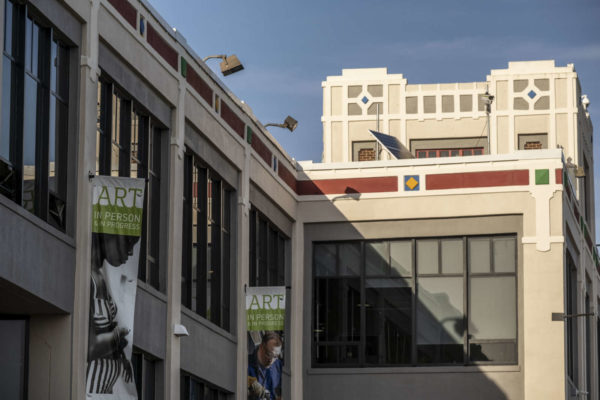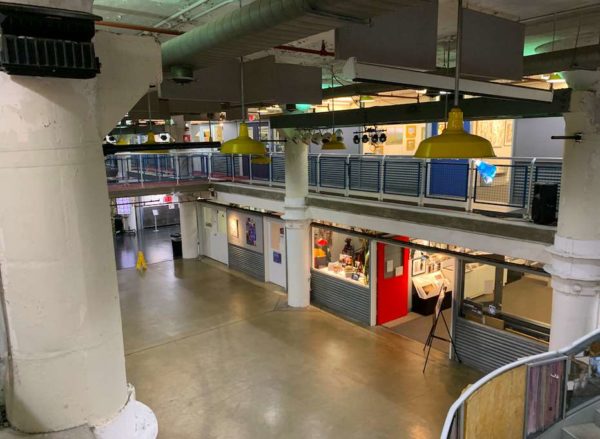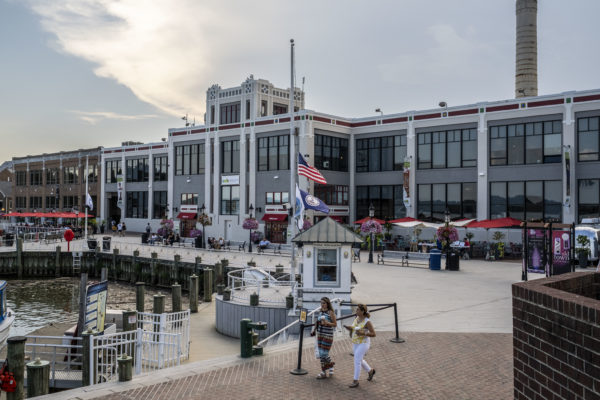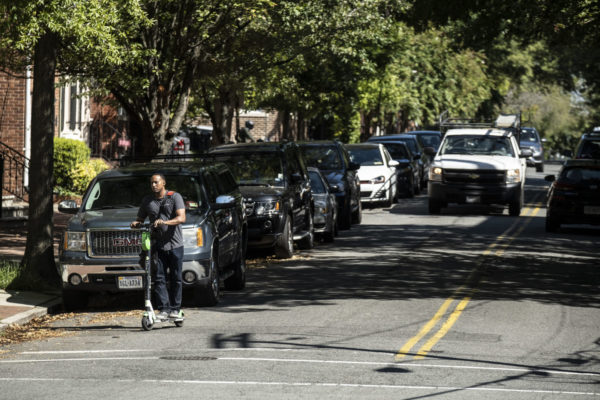While City Council usually has the final say over big decisions, much of the city’s future starts taking shape in Alexandria’s boards and commissions. After two years of those meetings going online and recorded for public viewing, many of them are starting to go offline again.
The Waterfront Commission, for example, has been where many of the details about flooding in Old Town have been hashed out. The 7:30 a.m. meetings have historically had fairly light public attendance. With the start of the pandemic those meetings were recorded and published online until last month, when the group stopped recording meetings.
City leaders have repeatedly called expanded public participation in meetings one of the few good things to emerge from the pandemic — along with to-go cocktails. At AlexTV, those curious about city policies can view a backlog of everything from Transportation Commission meetings to meetings of the Sister Cities Committee, but over the next few months that selection will start to slim down.
Alexandria communications officer Andrea Blackford said the authority for full virtual meetings was an emergency authority that will go away with the expiration of the City’s declaration of emergency at the end of June. That change doesn’t prevent the city from recording and publishing footage of meetings, but Blackford said it’s a question of staff resources.
“The FOIA open meetings rules allow for limited electronic participation by members of public bodies and do allow for unlimited participation electronically by staff or the public,” Blackford said. “However, the actual meeting of the public body has to be in person with a quorum of members in the room. Virtual participation by the public while the public body is meeting in person, known as a hybrid meeting, is much more resource intensive to conduct than a fully virtual meeting, due to the technology requirements for a hybrid meeting.”
While Blackford said that while hybrid meetings of the City Council and Planning Commission will continue, the city doesn’t have the manpower to continue with hybrid meetings for other commissions.
“Therefore, some boards and commissions may need to hold in-person meetings without a virtual component because the City does not have the resources available for all boards and commissions to conduct hybrid meetings,” Blackford said. “The legal rules apply the same to all public bodies — including all boards, commissions and City Council. We have prioritized hybrid meetings of the City Council and Planning Commission as those are the meetings with the most public participation.”
The city of Alexandria is getting ready to drop $102 million to fix flooding along the waterfront.
A proposal by the Waterfront Commission’s Flood Mitigation Committee, pitched to the Waterfront Commission at their April 19 meeting, outlined the potential pump stations, underground stormwater detention chambers, and streetscape and other stormwater infrastructure improvements for the ongoing efforts to implement the Waterfront Small Area Plan.
“This scenario has an estimated cost of approximately $102 million, consistent with the CIP funding allocated to Waterfront Small Area Plan implementation,” the draft plan said. “According to City staff, estimated costs are accurate at the level of detail appropriate for this stage in the planning process. Affordability will continue to be evaluated during the design-development process as construction and material costs continue to escalate in excess of historic average rates typically used to account for inflation.”
The cost is scaled back from earlier plans with cost estimates ranging from $170 million to $215 million.
Its proposed features include pump stations in Waterfront Park and the Queen Street right of way, south of Founders Park, underground stormwater detention chambers under Waterfront Park and Founders Park, and retention of the recent improvements in northern Waterfront Park at the foot of King Street,” the plan said.
The plan indicated areas where costs were cut, like using a cost-effective paving material in the streetscape improvements, but other bigger costs were averted by shifting the focus from ideal improvements to restoring the existing waterfront bulkheads.
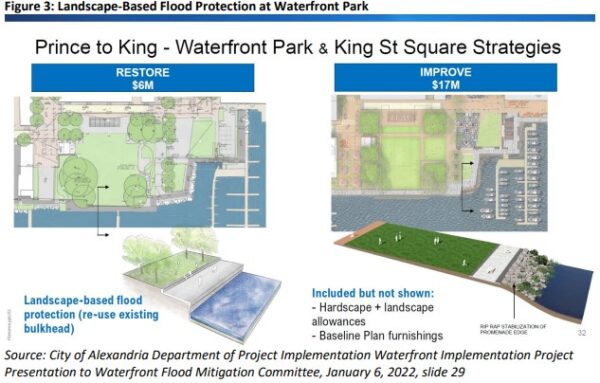
This would maintain the existing bulkhead rather than replacing or encapsulating it in its entirety. This approach will provide the intended level of flood protection at a reduced capital cost. Both staff and the committee acknowledge that deferred investments in eventual bulkhead replacement will still be required, and not precluded, by this approach.
The plan also notes that some of the improvements cut back in the plan should still be pursued in later budgets:
CIP funds allocated by City Council to Waterfront Small Area Plan implementation were originally intended to complete a full slate of waterfront capital projects, including parks and flood mitigation improvements. Given recent changes in program scope and high capital cost escalation, the budget is no longer sufficient to accomplish all anticipated elements. The committee recommends that additional budget be reserved in future year CIPs to finish parks as envisioned in the plan, or that alternate revenue streams be adopted to fund park and public space improvements. In addition, the City should continue to proactively pursue funding from federal and state grant programs, private philanthropy, and other sources to fund improvements that realize the City’s vision for the waterfront.
The document said that, where possible, the plan has built-in options for future investments. In other cases, like at Waterfront Park, future improvements could cost more in the long-term as a result of having to redo parts of the park.
Almost exactly four years after archeologists recovered three 18th-century ships from under the Old Town Waterfront, Alexandria is planning on sending at least two of them back to Davy Jones’ Locker.
Three ships were discovered under the Robinson Landing construction site in March 2018. While the most intact of the trio was sent to Texas A&M for study and will get a new Torpedo Factory exhibit next month, the other two have sat in water tanks in the DASH bus barn. At a meeting of the Waterfront Commission, City Archaeologist Eleanor Breen said that sometime this year the city will start moving the ships out of their 12×24-foot tanks and out to Ben Brenman Pond (4800 Brenman Park Drive).
“Based on [an] assessment, the recommendation was that [the ships] be stored at the bottom of Ben Brenman Pond; at the south end of the pond,” Breen said. “Jack [Browand, division chief of Parks and Cultural Activities] summarized it perfectly the other day: ‘We’re resinking three ships in a pond five miles west of where they were found.”
Breen noted this isn’t the first time rediscovered ships from this time period have been resubmerged. A Revolutionary War-era barge was discovered then re-submerged near Baltimore. Breen said the pond was chosen because it was the least risky to the timbers and would be the easiest to access. The “ponding” project received funding in the FY 2021 CIP.
“We’re finalizing the project schedule, including a date for pre-construction meeting on-site,” Breen said. “It will begin in April and last 4-6 months. We will offer a family-friendly event during ‘ponding’ process and in the future will be installing site interpretation.”
Meanwhile, Breen said a feasibility study for a potential new waterfront museum could start later this year with the idea of the museum eventually being home to the most intact ship. The study will look at potential funding and business models, as well as reviewing the sustainability of a waterfront museum.
The City of Alexandria is still mulling over what to do with the Torpedo Factory, but one way of paying for the expensive additions could lie in a program started under FDR.
At a meeting of the Waterfront Commission, representatives from the Alexandria Economic Development Partnership (AEDP) outlined one potential path to financing the Torpedo Factory overhaul as part of a “public real estate entity.”
Christina Mindrup, VP for commercial real estate at AEDP, said the partnership has been considering the creation of a new public real estate entity that could help “unlock new financial resources” to assist with arts development in Old Town North, some of which has been stalled and fallen behind the pace of attached developments.
Mindrup said that AEDP is working with the city to assess whether this public real estate entity could absorb the Torpedo Factory.
“AEDP working with city manager office to evaluate whether [Torpedo Factory Art Center] building could be included with assets financially managed by public real estate entity in Old Town North,” Mindrup said. “We’re now exploring options for expanding role of the real estate entity to include governance of TFAC.”
The topic of TFAC changing governance has been a touchy one, but Mindrup said the change could open up a new source of funding in the Industrial Development Authority (IDA) of Alexandria. The low range of cost estimates, essentially the “do-nothing” build with only the most basic of needed repairs and improvements, is still estimated at $16 million. Cost estimates for more substantial improvements range up to $41.5 million.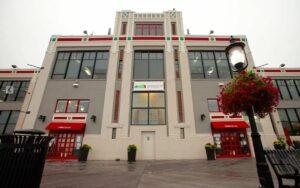
“For those who don’t know, the Industrial Development Authority has been around forever,” Mindrup said. “It’s been around back to Franklin Delano Roosevelt. It was used to help jurisdictions rebuild and put investment in the area.”
Specifically, Mindrup said the IDA can issue tax-exempt bonds to borrow at lower interest rates to fund improvements. It’s a program already in use at other developments, such as the hospital development at not-Landmark Mall.
“This would become a financing tool to help us fund improvements towards the Torpedo Factory,” Mindrup said. “It’s really just a low-interest loan that’s a tool for non-profits.”
AEDP leadership emphasized that the program is just one of several tools being considered, but AEDP President and CEO Stephanie Landrum said one benefit is it could be a revenue source outside of the already strained city budget.
“[We were] asked , as the city is looking at particular governance models, some of which might create a nonprofit or ownership of building not by the city, what models are available to finance improvements,” Landrum said. “There is a cost for improvements that needs to be made that is large and we do not have the money to pay for it. The only way we’ve been looking for that money is traditional CIP or city budget.”
Landrum said AEDP is examining changes to funding that could be made under a different governance model.
“We’re looking at: if the government model changed, could IDA funding be made available?” Landrum said.
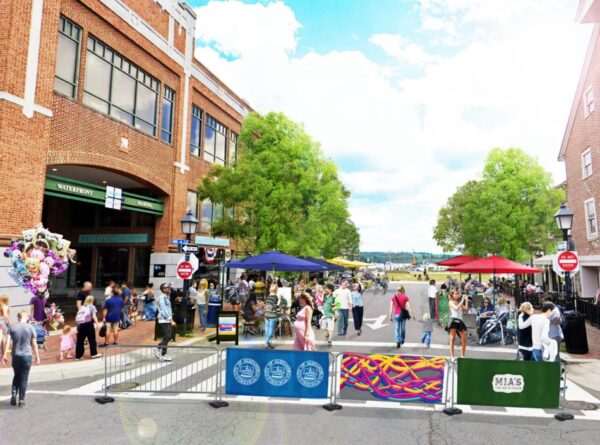
Alexandria could be converting another block of King Street to a pedestrian-only zone this spring.
At a meeting of the Waterfront Commission earlier this week, city staff presented both plans for a pilot to close the waterfront end of King Street and examined the future of the 100 block of King Street, which has been permanently closed and converted into a pedestrian zone.
Transportation Planning Division Chief Christopher Ziemann said a pilot to close the first block of King Street — called the unit block — would be a three-month program and would run from Memorial Day to Labor Day. The closure would also hook around to close part of The Strand.
The closure would still allow for emergency vehicles and maintenance vehicles to access the block but would be closed to other traffic. The closure would also eliminate some park spaces along both King Street and The Strand.
During the pilot, Ziemann said staff would check in with stakeholders, monitor the closure’s impact, and collect public feedback.
Waterfront Commission member Nathan Macek led a vote to support the closure pilot, but with the refinement of some of the parking, deliveries and crosswalks sections. The motion passed with only City Council member Sarah Bagley abstaining because it would be headed to City Council for a vote.
Kayte North, division chief of Mobility Services, also provided an update on future improvements to the 100 block pedestrian zone.
“We’re working on implementing short-term improvements to make this block a little nicer while we wait to see if we can turn this into a capital project for the future,” North said. “We had some ARPA money allocated to this block, so we’re using that money for these projects.”
There are currently metal barricades along the block, but North said the city is looking at adding bollards in the future. Long term, North said staff are looking at putting future improvements together as a capital project to be budgeted accordingly.
A more short-term change, North said, is making the curbside pickup and loading zones on Lee and Union streets — currently implemented as a temporary measure — permanent. North said this change would also let the city put up more permanent signs to show that these are no parking areas intended for loading and curbside pickup only.
“In the past, we’ve had some problems with the signs we put up disappearing, so we’re working on different sign text to put up there,” North said. “Those would probably be installed in the next month or so.”
As the city refines the pedestrian zone, Macek said he hopes the city does more to push car parking further by a car length or two from the intersection of King and Union streets.
That creates a pedestrian visibility hazard at what are two very busy crosswalks on both the north and south side of King Street at the Union intersection. The more we can get rid of cars at that immediate intersection, the easier it becomes for people to cross and not feel like you’re trying to dodge out in front of a car parked right there… Let’s be realistic about this. We’re talking about space for one person to park their car versus hundreds of people who walk through that intersection. It’s not like we’re saying we’re getting rid of all the parking in Old Town by doing this. We have to be willing to say the benefit of one person being able to park their car there for a few hours is overridden by all of the people who cross there who would benefit.
While North said city staff is hesitant to recommend anything that could result in more parking loss, they would look into it. Waterfront Commissioner Gina Baum warned that Old Town residents could likely object to any further loss of parking in the area.
After taking some flack for not having the financial impacts at-hand; Diane Ruggiero, director of the Office of the Arts, returned to the Waterfront Commission on Monday with pricing for modernizing the Torpedo Factory.
Julian Gonsalves, assistant city manager for public/private partnerships, talked through the cost estimates for the Torpedo Factory overhaul. Continuing as-is, with relatively minor building repairs funded over time with artist space being left mostly untouched, was priced at $16 million.
Gonsalves said continuing as-is — called incremental revitalization in the city plans — keeps the existing rent policy in place, but Gonsalves said that the current rent structure essentially only covers the cost of maintaining the building and not any of the proposed improvements to the building like new restrooms or increased waterfront access, so those capital improvements would only be made when there is room in the annual Capital Improvement Plan budget.
The underlying theme from the city’s presentation was that if the city is going to invest more into the Torpedo Factory, it wants a more vibrant and active attraction than what currently exists. The more sweeping changes under consideration would be leasing out the ground floor to private development, but city staff and ultimately the Waterfront Commission are more favorable toward a “custom program” — where the city retains ownership of the building and coordinates public-private partnerships for the ground floor.
Both the custom program and the ground floor leasing option — which amount to differences in management rather than significant architectural changes — are priced at $41.5 million. That price includes some foundational work that allows for new waterfront access and other changes to the ground floor, new restrooms, and “tenant improvements and enhancements.”
Gonsalves said the construction would likely start in 2025 and take 18 months, during which artists may be relocated to a different space.
Another takeaway from the financial considerations is that the dream of rooftop access is more or less dead. Making the rooftop feasible for use would cost an estimated $27.8 million; a combination of foundation reworking costs to support rooftop use and needed accessibility changes, like new elevators and stairs. The staff report indicated that the total cost to build and maintain the roof as a usable space far exceeded the potential revenue gained from any rooftop use.
The custom and ground floor leasing plans have drawn some backlash from artists for reducing the overall studio space in the building. During the meeting, city staff tiptoed around the issue, portraying the potential ground-floor restaurant use as “culinary arts” and saying the changes give the chance to bring in a wider range of artistic spaces like glassblowing studios.
“All the scenarios present the artists being there,” Gonsalves said. “This will be an art-focused building. This is not the artists being moved out of the Torpedo Factory. This is to ensure that we can plan for the Torpedo Factory of the 21st century.”
But Gonsalves did acknowledge that overall studio space for artists in the new plans would decrease. Diane Ruggiero, director of the Office of the Arts, said that more limited studio space might be better used by artist collectives rather than individual artists.
Reception from the Waterfront Commission was mixed.
“These are not specific plans despite years of studies,” said Commissioner Christina Watters. “We are now getting a quickly thrown-together plan that does not take responsibility for what needs to happen here. Artists have been engineered out.”
Watters also said the city is selectively using profitability as a measure of what to include, noting that a single restaurant operating on the ground floor is unlikely to be the revenue-generating machine that will recoup the costs of construction.
“I think the thought that looking at the Torpedo Factory, one of the jewels of our waterfront, as a negotiable source of revenue that we would farm out to some developer who would make the future profits is a grave mistake,” Watters said.
Commissioner Gina Baum was less sympathetic to the concerns of decreased artist studio space.
“[The] artists have been oppositional…at every turn have taken an oppositional stance,” Baum said. “I’ve had it with the do-nothing crowd… If the artists want to continue to fight like they are, they are going to dig their own grave. That is the reality of this situation. The city cannot afford to just sustain this as-is. Something needs to be done.”
Baum also dismissed a petition by artists to save studio space, calling it “garbage” and saying that she was sure that half of those signing don’t live in Alexandria.
The Waterfront Commission ultimately voted in favor of the custom program and will forward a letter of recommendation to the City Council for their meeting on Tuesday, Dec. 14.
The Torpedo Factory plan took a direct hit from the Waterfront Commission as Commissioners criticized staff for a rushed timeline that gives little room for public and commission feedback.
Plans are in the works to potentially overhaul the structure of the Torpedo Factory, with options like new cafe space on the first floor or artistic changes like a new glassblowing studio all being considered. But at a Waterfront Commission meeting earlier this week, the group unanimously voted to sent a letter to the City Council warning about the inadequate time given to considering public feedback at the end of the process.
While city staff have previously outlined potential changes to the layout of the Torpedo Factory, other important planning aspects like a cost breakdown are still unknown as plans went to the Waterfront Commission for review ahead of a City Council meeting next month.
At the meeting, Diane Ruggiero, deputy director of recreation, parks and cultural activities, explained that the Office of the Arts is working on a constrained timeline laid out by the City Council. Ruggiero explained that the timeline for the presentation of the Torpedo Factory plan was originally 18 months but was shrunk down to four months.
It’s a justification that went over poorly with members of the Waterfront Commission.
“You’re having a series of public meetings and then going to Council next week?” asked Commissioner Nathan Macek. “How does that provide any time for the public to provide feedback or for you to meaningfully incorporate that into what you’re bringing to City Council? This schedule is not realistic and I think you’re going to have to rethink it. I know you’re trying to get this in before this Council leaves, but I don’t think it’s fair to the community to cram this in at two weeks of the holidays and blame the schedule. You’ve had four months. You had four months. Failure to use the four months you had adequately shouldn’t be something we should be punished for and the community is given to react with.”
Chair Steve Thayer said it was unrealistic to expect the Waterfront Commission to be expected to endorse a plan lacking many of its basic elements.
“The devil is always in the details,” Thayer said. “There’s no way we’re going to have enough information to sit down in the middle of December and mix and match and decide what we think as a body. We’re well within our rights to tell Council we’re unable to fulfill our responsibilities because we received insufficient information.”
Staff from the Office of the Arts suggested holding a special meeting of the Waterfront Commission in December, but Thayer said that would likely create additional difficulties with trying to get all of the Commission members together around the holidays.
The concern expressed by many on the Waterfront Commission is that the stunted feedback time would erode public confidence in a plan already under fire from artists at the Torpedo Factory.
“The community at the Torpedo Factory is a bit up in arms, and if we rush this, there will be greater lack of trust,” said Commisioner Kristina Hagman. “We have to address this in some way, shape or form.”
While the Waterfront Commission was united in concerns about the timeline of the plan, there were some divisions over its content — with some saying the city hasn’t done enough to mollify artist concerns and others criticizing the artists for being unwilling to accept any changes.
“There was always a ‘do not do anything, do not change anything’ type attitude and I really like Diane’s changes for the building,” Hagman said. “I myself left the Torpedo Factory because it was a bit moribund. On the other hand, I think there will be a real distrust or community backlash, and I think that will be a real issue to deal with.”
The Waterfront Commission unanimously voted to send a letter to the City Council saying the Waterfront Commission did not have adequate time to consider the Torpedo Factory plans.
“Diane, I hope you understand why we’re upset with your office about this,” Macek said. “We asked you for information a month ago to provide adequate information to form an opinion on this. You’re running out the clock and saying ‘Sorry, this is the timeframe we’re on.’ That is not appropriate to back a commission into a corner with that… It’s just not the way business should be done in the city.”
The foot of King Street flooded with water is a dramatic visual that comes up nearly every time there’s flooding in Alexandria, but the city is facing some sticker shock for a long-planned fix.
At a meeting of the Waterfront Commission Flood Mitigation Committee this week, city staff presented a variety of plans that could help combat flooding on the waterfront, from a pair of cost-conscious options to options that put focus more on results than staying within budget.
City staff said that the three main sources of flooding on the waterfront are:
- Stormwater overwhelming the stormwater-sewer system
- The river backing into the sewer system
- The river “overtopping” and coming into Old Town streets and parks
Matthew Landes, division chief for project implementation, said the last one — overtopping — happens less frequently than the other two. Landes presented two cost-based options for combatting flooding on the Waterfront within the capital improvement plan’s $100 million allocation for Waterfront improvement, but neither will fully fix overtopping from the river.
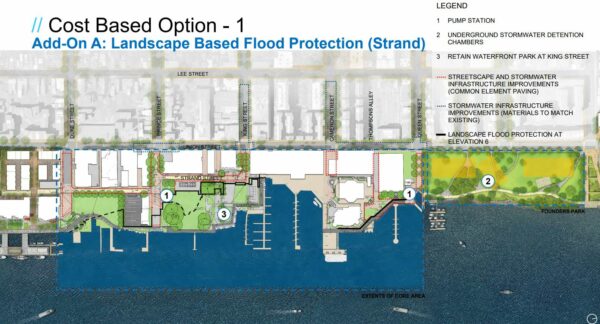
The first, which covers the Waterfront from Duke Street up to the northern end of Founder’s Park, mitigates rainfall flooding but makes no shoreline or park improvements. A combination of pumping stations, use of underground space at Founder’s Park, and more would help retain and remove floodwaters in the area. The project is estimated to cost $90 million, but staff said that could range from $63-136 million.
“On this project, we are prioritizing rainfall-runoff mitigation,” said project engineer Sara Igielski. “What that means we have to make sacrifices in terms of the other flooding that we have seen but we have identified rainfall-runoff and that backflow as being critical to addressing the funding we see most frequently.”
Landes said the project would meet two of the three objectives for managing water, but would do little to nothing for situations where the river rises and floods Old Town.
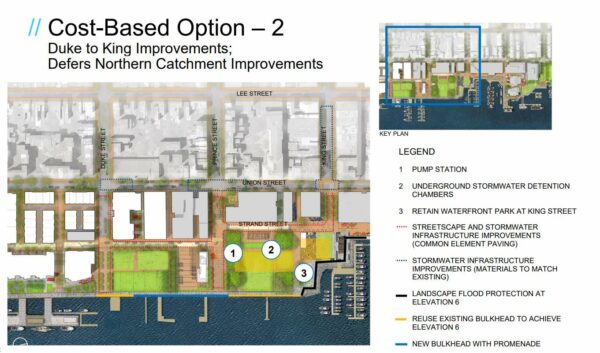
The other cost-based option presented would be hyper-focused on the area between Duke Street and King Street and would defer improvements north of King Street. The project would add a new bulkhead on the promenade along with a pumping station and underground retention at King Street park, but still would not hit all three of the flooding issues for Old Town and staff expressed concerns that flooding upstream could still lead to flooding in this area.
“This does not meet our flood mitigation goals,” Landes said. “It does not remove all of the floodings as we would want it to when we invest $100 million.”
But while staff also expanded on some more comprehensive and more expensive options with estimated costs of $170 million and $215 million, Committee members balked at proposed budgets.
“Everything you’re doing is more than we can afford,” Committee member Nathan Macek said. “That’s one-and-a-half elementary schools. I can’t imagine spending that kind of money to fix the flooding in this part of the city.”
Macek also noted that the Waterfront Small Area Plan approved in 2012 was intended as a parks and recreation plan, not an infrastructure plan, and the plans put forward by staff would allocate the full budget for the plan into flooding infrastructure. Macek said a more realistic approach might be building-specific enhancements to safeguard against damage from flooding.
“Everything we’re talking about here, to me, as much as I love the Waterfront, I couldn’t fathom the city spending this kind of money on this area,” Macek said. “Look at the flood problems we have here in Rosemont and other parts of the city with [$200-$300 million improvements] that will affect more homes and properties. [The] improvements and alternatives need to be paired back to be as minimal as possible while still providing amenities on the parkland.”
Trae Lamond, Committee member and owner Waterfront restaurant Chadwicks (203 Strand Street), said the first cost-based option was more than ample in its flood protection, but that the city can’t afford to defer the issue much longer.
“I would hate for us not to do anything and then have something terrible happen,” Lamond said.
The city is looking to make its scooter pilot program permanent, but hopefully with some changes that make them less intrusive for local pedestrians and residents.
Victoria Caudullo, shared mobility planner for the City of Alexandria, spoke to the Waterfront Commission this week to discuss some of the ambitions and limitations of the scooter program moving forward.
Caudullo said that many of the elements of the existing program, like the requirement for 30% of the scooters deployed to be in designated “equity zones”, will remain intact going forward. Restrictions on riding on the waterfront and city parks will also remain in place.
One of the biggest goals of the plan moving forward, Caudullo said, is adding more parking corrals for the scooters. So far, corrals have not edged into on-street parking, but Caudullo said that’s a possibility being considered.
“We want to increase the number of scooter corrals, but there might be a time where the only option is to install them in on-street parking,” Caudullo said.
If the city wants to replace some on-street parking with scooter corrals, Caudullo said that would go through the Traffic and Parking Board.
The city is also hoping to increase “education and public engagement” in the future — polite city-speak for getting people to stop dumping their scooters on the sidewalk or private property.
“We’re encouraging companies to require users and deployment teams to take a photo after use,” Caudullo said, “specifically to reach people who are parking incorrectly every time.”
For local residents, some on the Waterfront Commission said the big frustration is not knowing what to do about scooters that are obstacles in the public right of way and park spaces. Some on the Waterfront Commission suggested potentially dropping the speed on scooters to zero in prohibited zones, but Caudullo explained that there’s concern this could further incentivize abandoning vehicles.
“That could lead to a potential build up, even more so than we see now, at the edge of the waterfront,” Caudullo said.
For others, making it easier for residents to report scooters parked errantly could fix the feeling of helplessness from some residents.
“When I walk outside and open my door on Saturday morning and there’s two Uber-line scooters laying across the sidewalk: literally, what do I do next?” said Waterfront commissioner Beth Gross. “There’s no phone number on there to call. Is the proper thing to do Alex311? I think there’s a missing piece that’s the actual step people are supposed to do… I think you’d get more support from people who don’t use them who find them a nuisance if there was a simpler way to address that concern.”
Caudullo said scooters should have contact information visible, but the city would be pushing to make that more visible.
“People are welcome to try and fix it themselves,” Caudullo said. “I know that’s not an ideal request. Barring that it would go to the company. I’m concerned to hear there was no phone number on the devices. There should be on the devices. That’s concerning to hear and I’ll look into that, but the idea is to reach out to the company using their phone number or their app. It’s not a perfect system. We’re trying to find a better way of doing this.”
Sheriff Dana Lawhorne to receive Lifetime Valor Award — “In recognition of his retirement, we are pleased to honor Sheriff Dana Lawhorne with a Lifetime Valor Award at this year’s Valor Awards. Join us virtually, on June 22nd, to honor Sheriff Lawhorne’s 43 years of law enforcement service to Alexandria.” [Chamber ALX]
West End Business Association hosting 1 p.m. conversation with Mayor — “Take this opportunity to ask questions and connect with Mayor Justin Wilson about how he would continue to serve the city of Alexandria.” [WEBA]
Chinquapin Recreation Center closing for improvements June 26 — “The City of Alexandria’s Chinquapin Park Recreation Center and Aquatics Facility (3210 King St.) will close Saturday, June 26 through Monday, Sept. 6, for several planned facility improvements and annual cleaning.” [Zebra]
Vaccine Equity Clinic on Route 1 in Fairfax County offering free transportation — “The Health Department and Fairfax Connector have partnered to offer free transportation to those who want to get vaccinated at the clinic, located in the former Safeway site at 7451 Mount Vernon Square Center in Alexandria. Fairfax Connector’s Free Vaccine Shuttle will run along Fairfax Connector’s line in that region.” [Fairfax County]
Annual Waterfront Commission walk is today — “The walk will be in person starting at (5 p.m. at) the intersection of Oronoco and South Union Streets and will proceed south to Robinson Landing. The walk is anticipated to end at 6:30 p.m.” [City of Alexandria]
Fire Department conducting community meeting on restructuring today — “The Alexandria Fire Department (AFD) will implement an organizational restructure, effective Saturday, June 12, 2021. The goals of the changes are to improve service efficiency and response times across the City; reduce cost; increase safety on the roadways; and improve response preparedness for specialty teams such as the Technical Rescue, Hazardous Materials, and Inland Water Rescue teams. AFD Representatives will present the upcoming changes to the community and answer questions.” [City of Alexandria]
Today’s weather — “Rain showers in the morning with numerous thunderstorms developing in the afternoon. High 81F. Winds ENE at 5 to 10 mph. Chance of rain 90%… Thunderstorms in the evening, then variable clouds overnight with still a chance of showers. Low around 65F. Winds E at 5 to 10 mph. Chance of rain 70%.” [Weather.com]
New job: Ghost tour guide — “US Ghost Adventures, a national tour operation is seeking energetic storytellers to lead 90-minute walking tour groups downtown. This part-time position is ideal for self-motivated candidates looking for a fun way to make extra income in the evenings.” [Indeed]


